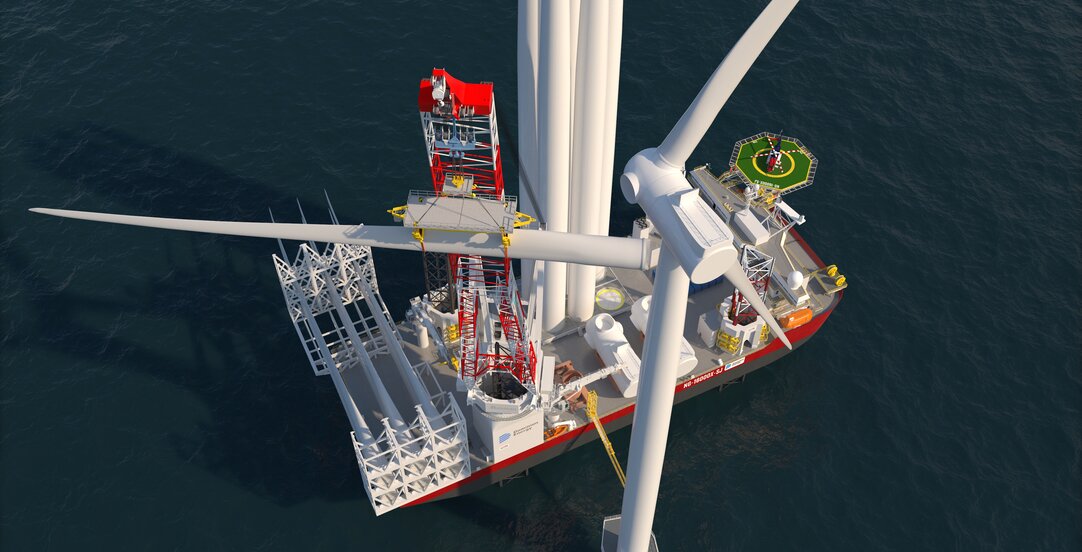Post-Trump: The Winds of Change Opportunities for offshore wind farm installation vessels in the US

Despite the USA having what has been described as a “globally significant wind resource”, the development of the offshore wind industry in the United States has had something of a slow start, with only 5 electricity generating turbines currently in operation in US offshore waters with generating capacity of only around 30 MW.
Reading time 5 minutes
Despite the USA having what has been described as a “globally significant wind resource”, the development of the offshore wind industry in the United States has had something of a slow start, with only 5 electricity generating turbines currently in operation in US offshore waters with generating capacity of only around 30 MW.
By way of comparison, Europe has over 5,000 grid connected offshore wind turbines spread across 12 countries with capacity of approximately 25 GW (1 GW equals 1000 MW).
Changing sentiments to offshore wind in the US
Why the US are so late to the party is without doubt partly due to a lack of political will on the part of successive presidential administrations to take on the hugely powerful fossil fuel lobbies in the USA. Clearly, scepticism to the efficacy of renewable energy sources, and offshore wind in particular, has also played a role. Indeed, as recently as December 2020, President Trump, widely credited being a renewables sceptic, was quoted as saying “I never understood wind… You know I know windmills very much. I’ve studied it better than anybody. I know it’s very expensive.”
With the election of a more climate-conscious Biden Administration in January 2021 however, it seems that the situation is set to change, with President Biden pledging within his first few weeks in office to deploy 30 GW of offshore wind in the US by 2030.
This is clearly a hugely ambitious target and one that will require a very rapid scaling up of the US’s domestic offshore windfarm component supply chain, vessel spread (in particular the highly specialised wind farm installation vessels) and port infrastructure needed to service this fledgling industry. In doing so, they will undoubtedly have to leverage off and rely heavily on the vast reserves of knowledge and experience built up over the past 20 years in the European sector (just as the North Sea oil industry benefitted from the knowledge and experience of the US oil industry back in the 1970s), thus presenting a myriad of opportunities for the more experienced European and other industry players.
The extent of the opportunity
For owners of wind farm installation vessels however, the opportunities for directly deploying their tonnage are likely to be limited by the impact of various US protectionist laws built into US federal law, including the Merchant Marine Act of 1920, more commonly known as the “Jones Act”, which requires that all goods transported by water between US ports be carried on ships that have been constructed in the US and that fly the US flag, and are crewed and owned by US citizens and/or US permanent residents.
The impact of the Jones Act therefore effectively precludes vessels built and owned outside of the US from being employed in connection with the construction of US offshore wind farms, unless they operate out of non-US ports (e.g. in Northern Europe or Canada), and/or receive components and crew delivered by Jones Act compliant feeder vessels, neither of which present particularly efficient solutions in the context of a large scale infrastructure project located close to the US seaboard.
Non-US vessel owners will therefore have to look at more creative options if they are to gain any market share, either by accepting more of an advisory role or by looking at establishing US subsidiaries or joint ventures which pass the “US owned” test and which can then contract for US built vessels.
Whichever way we look at it however, in order to deliver on President Biden’s ambition, a newbuilding programme will be required to build a new US flagged, US built fleet of wind farm installation vessels.
Whilst US shipyards have a tradition of building high quality vessels, the costs of construction in the US are generally regarded as being significantly higher than the equivalent construction costs at for example a South Korean or Chinese shipyard (with estimates ranging from the costs being anywhere between 50 and 100% higher). For those that can swallow such costs however, the future employment opportunities, particularly for those who are first to market, look extremely positive.
First to market
In readiness to meet the projected demand, the first industry player to place an order for a Jones Act compliant wind farm installation vessel was Virginian power and energy company, Dominion Energy who contracted with Keppel Amfels in Brownsville, Texas (a US subsidiary of Singapore’s Keppel Offshore and Marine) in 2020 for the construction of a Gusto-MSC designed wind farm installation vessel with crane capacity of 2,200 tons. The vessel, to be called “CHARYBDIS”, is expected to be operational in late 2023 and will be deployed first to assist Ørsted with the construction of the 704 MW Revolution Wind and 880 MW Sunrise Wind developments off the US North Eastern seaboard before supporting construction of Dominion’s own 12 MW Coastal Virginia Offshore Wind pilot project off the coast of Virginia.
UK based owner Seajacks International, who themselves were one of the first to market in the wind farm installation sector in the North Sea, are assisting Dominion Energy with construction supervision and operations oversight.
Wikborg Rein LLP has assisted Seajacks International with various aspects of its role as construction and operations advisor to Dominion Energy.
Main photo: dominionenergy.com
The Merchant Marine Act of 1920 is a United States federal law which provides for the “promotion and maintenance of the American merchant marine” and amongst other things regulates maritime commerce in US waters and between US ports. The act requires, inter alia, that goods transported by waters between US ports be carried on ships that have been constructed in the USA, that fly the US flag and are owned by US citizens and are crewed by US citizens and US permanent residents. The act was introduced by Senator Wesley Jones who lends his name to the act’s more common moniker, the “Jones Act”.
